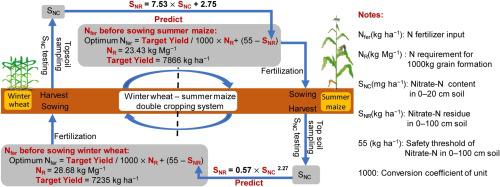Field Crops Research ( IF 5.8 ) Pub Date : 2021-08-02 , DOI: 10.1016/j.fcr.2021.108258 Zujiao Shi 1 , Donghua Liu 1, 2 , Miao Liu 1 , Muhammad Bilal Hafeez 1 , Pengfei Wen 3 , Xiaoli Wang 1 , Rui Wang 1 , Xudong Zhang 1, 2 , Jun Li 1

|
The recommendations for soil fertilization based on soil testing are time-critical and labor-intensive for farmers in the winter wheat–summer maize double cropping system. Understanding the relationships between the crop yield, nitrogen requirement, and nitrate residue level under the combined N and P fertilizer application is necessary to optimize the fertilizer recommendation method in order to reduce the nitrate residue levels. In 2009, we established a long-term field fertilization experiment with five N application rates and four P application rates in the winter wheat-summer maize double cropping system. The grain yield, N requirement, and soil nitrate residue were determined during 2016–2019 to optimize the N inputs for nitrate residue control. The crop yield was increased by N application and it increased further when combined with P fertilizer. The N requirement of crops increased by N application but decreased when combined with P. The calculated maximum winter wheat yield was 7235 kg ha−1 and the theoretical N requirement for 1000 kg grain formation (NR) was 28.68 kg Mg−1. The maximum summer maize yield was 7866 kg ha−1, and the theoretical NR was determined as 23.43 kg Mg−1. The residual nitrate-N was increased by N application but decreased by combined P fertilizer. The correlation between the nitrate-N content in 0–20 cm top soil (SNC) and nitrate-N residue in 0–100 cm soil (SNR) was linear at the winter wheat harvest but exponential at the summer maize harvest. Thus, the SNR can be predicted by the SNC according to their correlation at the harvest. The predicted SNR at the harvest of the previous crop, the target yield and NR for the subsequent crop obtained from long-term in-situ observations can be used to guide the fertilizer amounts applied to the following crop. Therefore, we developed a convenient method to optimize the fertilizer recommendation method for the winter wheat–summer maize cropping system.
中文翻译:

旱作小麦-玉米双熟制硝酸盐残留控制的施肥优化推荐方法
基于土壤测试的土壤施肥建议对于冬小麦 - 夏玉米双熟系统中的农民来说是时间紧迫和劳动密集型的。了解氮磷复合施肥下作物产量、需氮量与硝酸盐残留水平之间的关系,对于优化施肥推荐方法以降低硝酸盐残留水平是必要的。2009年,我们在冬小麦-夏玉米双熟制度中建立了五施氮四施磷的长期田间施肥试验。在 2016-2019 年期间确定了粮食产量、N 需求和土壤硝酸盐残留,以优化用于硝酸盐残留控制的 N 输入。施氮可提高作物产量,与磷肥配合使用可进一步提高产量。作物对氮的需求因施氮而增加,但与磷结合时减少。 计算的冬小麦最大产量为 7235 kg ha-1和 1000 kg 晶粒形成 (N R )的理论 N 需求为28.68 kg Mg -1。最大夏玉米产量为7866公斤公顷-1,理论Ñ - [R被确定为23.43公斤镁-1。残留硝酸盐氮随施氮增加,但因配合施磷肥而减少。0-20 cm 表层土壤中硝酸盐-N 含量 (S NC ) 与 0-100 cm 土壤中硝酸-N 残留量 (S NR ) 之间的相关性在冬小麦收获时呈线性关系,但在夏玉米收获时呈指数关系。因此,S NR可以根据收获时的相关性由 S NC预测。预测的 SNR在先前作物,目标产量和N的收获ř从长期原位观测所获得的后续作物可以用来引导肥料量施用到作物以下。因此,我们开发了一种方便的方法来优化冬小麦-夏玉米种植系统的施肥推荐方法。



























 京公网安备 11010802027423号
京公网安备 11010802027423号